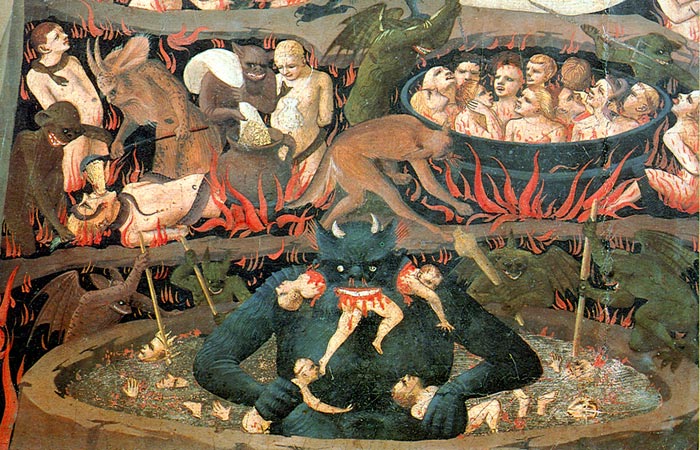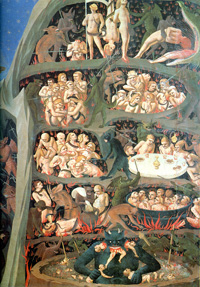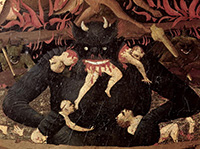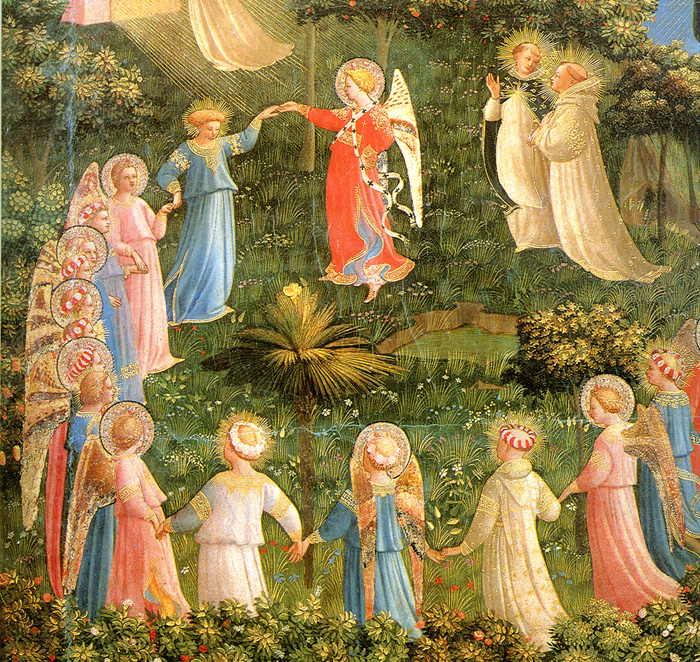| |
|
| |
|
|
|
|
|
|
| |
 |
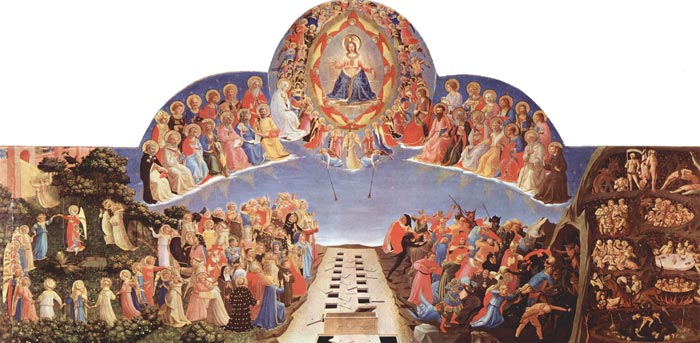 |
| |
Fra Angelico, Last Judgement, c. 1431, tempera on panel, 105 x 210 cm, Museo di San Marco, Florence
|
|
 |
|
| |
|
|
|
| |
|
Fra Angelico | Last Judgement, c. 1431
|
|
|
|
| |
|
The Last Judgment (tempera on panel) is a painting by Italian Renaissance artist Fra Angelico.[1] It was commissioned by the Camaldolese Order for the newly elected abbot, the humanist scholar Ambrogio Traversari.[2] It is variously dated to c1425, [3], 1425-1430 [4] and 1431.[2] It was originally sited in the church of Santa Maria degli Angeli [3] and now is in the museum of San Marco, Florence. It is not to be confused with another Fra Angelico Last Judgement in the Gemäldegalerie, Berlin.
Like most of Fra Angelico's work the iconography is standard for the contemporary treatment of the subject, which was among the commonest for painting in churches, though more often on walls. In the centre of the top of the picture, Christ in Judgement is shown sitting on a white throne with Mary, John, and all the saints judging the living and the dead. He is also surrounded by angels. This depicts him as the ruler of Heaven and Earth, one hand pointing downwards to Hell, the other up to Heaven. The section on the left of the painting shows Paradise. The Seraph Angels here lead the souls of the righteous and pure of heart to a beautiful garden. Here, Paradise is depicted as the Garden of Eden but has a gate with a light, representing Heaven. The section in the middle shows broken tombs. This represents that the dead have come out of their graves and tombs to be finally judged. The right section in this painting depicts Hell. The painting depicts the Demons of Hell torturing the souls of the wicked. The very bottom shows Satan chewing on some of the souls.
|
|
Fra Angelico, Last Judgement, Hell, c. 1431, tempera on panel, 105 x 210 cm, Museo di San Marco, Florence
|
|
|
|
| |
|
Elevated in the deep azure sky and surrounded by concentric rings of cherubim and angels, Christ sits on a glowing bank of clouds as he judges the world. He is flanked by the interceding figures of John the Baptist and the Virgin. Rows of saints and prophets, identified by their distinctive attributes, varied expressions and brilliantly coloured mantles, sit suspended on clouds in the heavens. A long row of tombs leads to the distant horizon, bisecting the valley below. To the right of Christ, the Blessed kneel in adoration, their faces radiant with the love of God, as angels dance in a circle in the verdant vegetation of Paradise. Golden rays of light stream through the open gates of the City of God and illuminate the white gowns of the Blessed seeking entry. To Christ's left, demons with pitchforks drive the agonized Damned into the mouth of a mountainous Hell. The ghastly torments that await them are portrayed within its flaming circles, where naked sinners, some strangled with snakes, suffer for their transgressions.
The abundance of figures (270 in all), nuanced evocation of their emotions, descending perspective of the row of tombs and ascending landscape reveal a mastery of narrative and space that was unprecedented in Angelico's small-scale works.
Like most of Fra Angelico's work, the iconography is standard for the contemporary treatments of the Last Judgement. Among the most common subjects of painting in churches, it is found more often on walls. In the top centre of the picture, Christ sits in judgement on a white throne surrounded by angels, Mary, John, and the saints. Christ is shown as judge of the living and dead, his left hand pointing down to Hell, his right up to Heaven. On Christ's right hand is paradise, with angels leading the saved through a beautiful garden into a shining city. In the middle are the broken tombs of the risen dead, come out of their graves to be finally judged. On Christ's left demons drive the damned into Hell, where the wicked are tormented. At the very bottom Satan chews on three of the damned, and grasps two others.
|
|
|
|
Fra Angelico, Last Judgement, Paradise, c. 1431, tempera on panel, 105 x 210 cm, Museo di San Marco, Florence
|
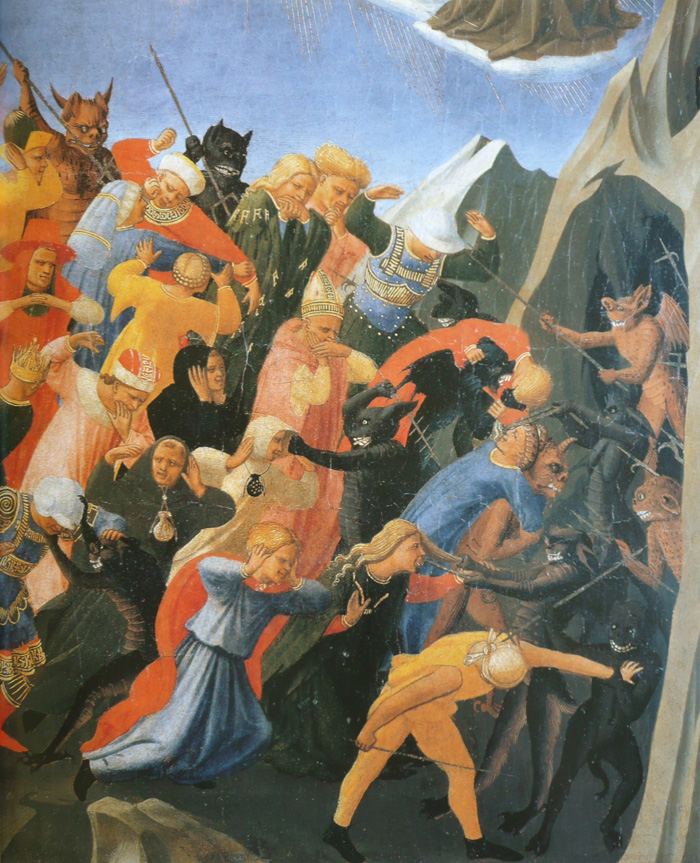 |
Fra Angelico, Last Judgement, detail, c. 1431, tempera on panel, 105 x 210 cm, Museo di San Marco, Florence |
| 
Giorgio Vasari | Lives of the Most Eminent Painters Sculptors and Architects, Fra Angelico | Detailed biography of the artist

[1] Fra Angelico was a Florentine painter, a Dominican friar, originally named Guido di Pietro. Although in popular tradition he has been seen as 'not an artist properly so-called but an inspired saint', (Ruskin), Angelico was in fact a highly professional artist, who was in touch with the most advanced developments in contemporary Florentine art and in later life travelled extensively for prestigious commissions.
Fra Angelico entered a Dominican convent in Fiesole in 1418 and became a friar using the name Giovanni da Fiesole. Although his teacher is unknown, he apparently began his career as an illuminator of missals and other religious books. He began to paint altarpieces and other panels; among his important early works are the Madonna of the Star (c. 1424, San Marco, Florence) and San Domenico Altarpiece with a predella representing Christ in Glory Surrounded by Saints and Angels (National Gallery, London), which depicts more than 250 distinct figures. Among other works of that period are two of the Coronation of the Virgin (Uffizi, Florence and Louvre, Paris) and The Deposition and The Last Judgment (San Marco). His mature style is first seen in the Madonna of the Linen Weavers (1433, San Marco), which features a border with 12 music-making angels.
In 1436 some of the Dominican friars of Fiesole moved to the convent of San Marco in Florence, which had recently been rebuilt by Michelozzo. fra Angelico, sometimes aided by assistants, painted many frescoes for the cloister, chapter house, and entrances to the 20 cells on the upper corridors. The most impressive of these are The Crucifixion, Noli Me Tangere, and Transfiguration. His altarpiece for San Marco (1439?) is one of the first representations of what is known as a Sacred Conversation: the Madonna flanked by angels and saints who seem to share a common space. In 1445 Angelico was summoned to Rome by Pope Eugenius IV to paint frescoes for the now destroyed Chapel of the Sacrament in the Vatican. In 1447, with his pupil Benozzo Gozzoli, he painted frescoes for the cathedral in Orvieto. His last important works, frescoes for the chapel of Pope Nicholas in the Vatican, are Scenes from the Lives of Saints Stephen and Lawrence (1447-1449), probably partly painted from his designs by assistants.
Fra Angelico died in Rome and was buried in the church of S. Maria sopra Minerva, where his tombstone still exists. His most important pupil was Benozzo Gozzoli and he had considerable influence on Italian painting. He painted numerous altarpieces as well as frescos, several outstanding examples being in the S. Marco museum. His particular grace and sweetness stimulated the school of Perugia, and Fra Bartolommeo, who followed him into S. Marco in 1500, had something of his restraint and grandeur. Vasari, who referred to Fra Giovanni as a simple and most holy man, popularized the use of the name Angelico for him, but he says it is the name by which he was always known, and it was certainly used as early as 1469. The painter has long been called 'Beato Angelico' (the Blessed Angelico), but his beatification was not made official by the Vatican until 1984.
Fra Angelico combined the influence of the elegantly decorative International Gothic style of Gentile da Fabriano with the more realistic style of such Renaissance masters as the painter Masaccio and the sculptors Donatello and Ghiberti, all of whom worked in Florence. Angelico was also aware of the theories of perspective proposed by Leon Battista Alberti. Angelico's representation of devout facial expressions and his use of colour to heighten emotion are particularly effective. His skill in creating monumental figures, representing motion, and suggesting deep space through the use of linear perspective, especially in the Roman frescoes, mark him as one of the foremost painters of the Renaissance.
[2] a b Evelyn S. Welch , Art in Renaissance Italy, 1350-1500, Oxford University Press, 2000, p146. ISBN 019284279X
[3] Magnolia Scudieri, Museum of San Marco, Giunti, 1991, p17. ISBN 8809013417
[4] Silvia Malaguzzi, Fra Angelico, Giunti, 2003, p18. ISBN 8809030540
|
|
|
| |
|
|
This article incorporates material from the Wikipedia article The Last Judgment published under the GNU Free Documentation License.
|

Tuscany is one of the most popular tourist destinations in the world. Known for its enchanting landscapes, its fantastic and genuine food and beautiful towns as Florence, Pisa, Lucca and Siena. Tuscany is much more! Spas and thermal baths, natural parks and caves, traditional festivals & tastings. Podere Santa Pia, a former cloister with an authentic character, is located in the heart of the Valle d'Ombrone, and one can easily reach some of the most beautiful attractions of Tuscany, such as Montalcino, Pienza, Montepulciano and San Quirico d'Orcia, famous for their artistic heritage, wine, olive oil production and gastronomic traditions. It is the ideal place to pass a very relaxing holiday in contemplation of nature, with the advantage of tasting the most typical dishes of Tuscan cuisine and its best wines. Not far from Cinigiano and clearly visible from Podere Santa Pia, is the famous Castle of Poggio alle Mura, also known as Villa Banfi and home to one of the most popular producers of Brunello di Montalcino D.O.C.G. wine. Set in 7100 hectares of land in the Montalcino area, Castello Banfi il Borgo is one of the most important wine producers in Tuscany. This is the land where the DOC wines Montecucco and Brunello are produced. So, the surrounding countryside is the ideal area for an uncommon wine tour, visiting small farms producing wine and excellent extra virgin olive oil.
If you want to spend an unforgettable holiday at Podere Santa Pia, visit our special offers page or contact us. Experience the friendly welcome, unique interior and rural tranquillity... The large garden, stunning stone fireplace and indoor pizza oven, ancient timber beams, stone flag floors and many more period features contribute to the authentic atmosphere and individual charm that our guests enjoy time and time again.
|
|
|
 |
|

|
Podere Santa Pia, mystic holiday home in the heart of the Tuscan Maremma
|
|
Casa Vacanze Podere Santa Pia, Castiglioncello Bandini, Toscane
|
|
Colline sotto Podere Santa Pia con ampia vista sulla Maremma Grossetana
|
 |
|
 |
|
 |
Pools in a natural area, a dive into the heart of Tuscany
|
|
A beautiful spring morning by the pool, a natural jewel nestled amidst the verdant Tuscan hill
|
|
The night pool at Podere Santa Pia exudes a hypnotic sense of purity
|
| |
|
|
Fra Angelico in Palazzo Strozzi en Museo San Marco
Beato Angelico a Palazzo Strozzi e Museo di San Marco
26
September - 25 Januari 2026
The exhibition Beato Angelico at Palazzo Strozzi and the Museo San Marco explores the work, development, and influence of Beato Angelico's art, as well as his relationships with painters such as Lorenzo Monaco, Masaccio, Filippo Lippi, and sculptors like Lorenzo Ghiberti, Michelozzo, and Luca della Robbia.
It is the first major exhibition in Florence dedicated to the artist exactly seventy years after the 1955 monograph.
|
 |
|
 |
|
 |
Palazzo Strozzi, Firenze
|
|
Beato Angelico, mostra Palazzo Strozzi and Museo di San Marco, Firenze, 2025
|
|
Museo di San Marco, veduta posteriore
|
 |
|
 |
|
![Beato Angelico, panoramica della mostra con la Pala d'altare di San Marco ( 1438-1442) e la Pala di Annalena (1445 circa), Palazzo Strozzi, Firenze, 2025 [Photo: Ela Bialkowska, OKNO Studio]](https://lh3.googleusercontent.com/pw/AP1GczNBKAgi43MEhBHit3vK00YmiyRsTYQyXCemfRlLigP3CbVRrtBKkgplBTE7YAe4t75NoduxM-cz6UJYpKkyI_au_xMMOAZCkya_mWyNo7UG0rmBYveg=w2400-h1600-p-k) |
Beato Angelico, la grande mostra a Palazzo Strozzi, Firenze, sala 1
|
|
Beato Angelico, Pala della compagnia di San Francesco in Santa Croce (1428-1429) e Giudizio universale (1425-1428 circa), Museo di San Marco, Firenze
|
|
Beato Angelico, panoramica della mostra con la Pala d'altare di San Marco ( 1438-1442) e la Pala di Annalena (1445 circa), Palazzo Strozzi, Firenze, 2025
|
Museo di San Marco
|
|
|
|
|
The San Marco Museum occupies the oldest part of a Dominican monastery rebuilt by Michelozzo during the decade from 1436 to 1446 by appointment of Cosimo de' Medici the Elder.
Michelozzo attempted to use as much as possible the walls of the old building to create a monastery whose rooms and layout are in line with completely modern criteria of functionality, still recognisable today.
Overall, the building is a monumental complex with all the sobriety and elegance typical of Florentine Renaissance architecture.
On the ground floor, the rooms formerly used for community life: the Hospice for the pilgrims next to the entrance, the Chapter Hall, the Washroom, the Refectory and the adjoining room used for the kitchen and other facilities; there is also a small 15th-century cloister, called Chiostro della Spesa, and a courtyard, the so-called Granary Courtyard.
During this same period, the building was endowed with an extraordinary cycle of paintings by Fra Angelico who lived and lived in the monastery in 1387 and 1400-1455. A number of the ground-floor rooms house a remarkable collection of panel paintings by Fra Angelico: particularly fine are the Last Judgement, the Linaioli Tabernacle, the Deposition, the Silver Wardrobe doors.
The San Marco Museum also houses a number of works by Fra Bartolomeo (1472-1517), including a famous portrait of Savonarola.
The Library, the first Renaissance library open to the public, formerly held the Italian, Latin and Greek codices that belonged to the Humanist, Niccolò Niccoli, which later passed to the Laurentian Library.
It now holds a precious collection of over a hundred illuminated choir books from the Middle Ages and Renaissance, originating from this monastery and other suppressed monasteries and convents.
San Marco Museum | www.firenzemusei.it
Museo di San Marco
Piazza di San Marco, 1
50121 Firenze
Opening hours :
Monday-Friday: 8.15-13.50; Saturday: 8.15-18.50; Sunday: 8.15-19.00
Closed : New Year's Day, May 1st and Christmas Day
|
|
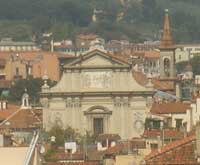
San Marco a Firenze |
| |
|
|
|
|
| |
|
|
|
|
| |
|
|
|
| |
|
|
|
| |
|
|
|
| |
|
|
|
| |
|
|
|
| |
|
|
|

